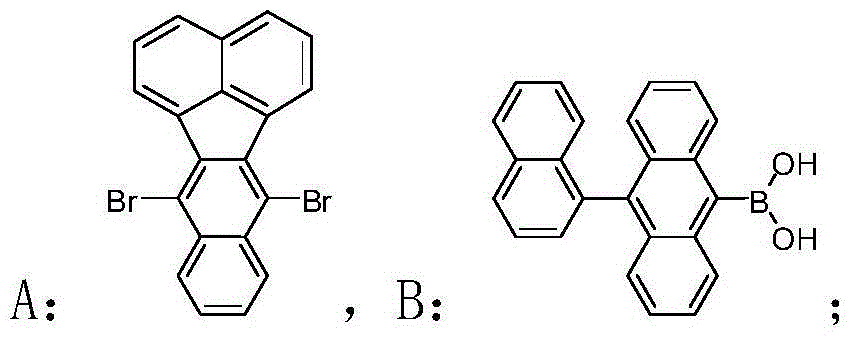Blue light organic electroluminescent material, preparation method and applications thereof
A luminescent and electromechanical technology, applied in the direction of luminescent materials, organic chemistry, chemical instruments and methods, etc., to achieve the effects of high emission energy, high fluorescence quantum yield, and high device efficiency
- Summary
- Abstract
- Description
- Claims
- Application Information
AI Technical Summary
Problems solved by technology
Method used
Image
Examples
Embodiment 1
[0036] Example 1: The blue-light organic electroluminescent material of this example, namely 7,12-bis(10-(naphthalene-1-yl)anthracen-9-yl)benzo[k]fluoranthene, the preparation steps are as follows:
[0037]
[0038] Under argon protection, 7,12-dibromobenzo[k]fluoranthene (82mg, 0.2mmol), 10-(naphthalene-1-yl)anthracene-9-boronic acid (139mg, 0.4mmol) was added to a 10ml In the flask of toluene solvent, after fully dissolving, potassium carbonate (2mL, 2mol / L) solution was added in the flask, vacuumized to remove oxygen and filled with argon, then added bistriphenylphosphine palladium dichloride (5.6mg, 0.008mmol); the flask was heated to 120°C for Suzuki coupling reaction for 24h. The reaction was stopped and cooled to room temperature, the reaction solution was extracted with dichloromethane several times and the organic phase was combined. After the organic phase was dried over anhydrous magnesium sulfate and spin-dried, the crude product was obtained, and the crude prod...
Embodiment 2
[0040] Example 2: The blue-light organic electroluminescent material of this example has a structure of 7,12-bis(10-(naphthalene-1-yl)anthracene-9-yl)benzo[k]fluoranthene, and the preparation steps are as follows :
[0041]
[0042] Under the protection of mixed gas of nitrogen and argon, 7,12-dibromobenzo[k]fluoranthene (123mg, 0.3mmol), 10-(naphthalene-1-yl)anthracene-9-boronic acid (230mg, 0.66mmol) and 15mL of tetrahydrofuran into a 50mL two-necked bottle, fully dissolved, and then a mixed gas of nitrogen and argon was introduced to exhaust the air for about 20 minutes, then tetrakistriphenylphosphine palladium (4mg, 0.003mmol) was added into it, fully dissolved and then Sodium bicarbonate (3mL, 2mol / L) solution was added. Then, the mixed gas of nitrogen and argon was exhausted for about 10 minutes, and the two-neck flask was added to 70°C for Suzuki coupling reaction for 48 hours. The reaction was stopped and cooled to room temperature, the reaction solution was extr...
Embodiment 3
[0043]Example 3: The blue-light organic electroluminescent material of this example has a structure of 7,12-bis(10-(naphthalene-1-yl)anthracen-9-yl)benzo[k]fluoranthene, and the preparation steps are as follows :
[0044]
[0045] Under nitrogen protection, 7,12-dibromobenzo[k]fluoranthene (123mg, 0.3mmol), phenylboronic acid (251mg, 0.72mmol), palladium acetate (3.5mg, 0.015mmol) and three (o-methylbenzene base) phosphine (21mg, 0.06mmol) was added to a flask containing 12mL of N,N-dimethylformamide, and after fully dissolving, potassium carbonate (3mL, 2mol / L) solution was added, and then nitrogen gas was passed into the flask to exhaust After about 30 minutes in air; the flask was heated to 130°C for Suzuki coupling reaction for 12 hours. The reaction was stopped and cooled to room temperature, the reaction solution was extracted with dichloromethane several times and the organic phase was combined. After the organic phase was dried over anhydrous magnesium sulfate and ...
PUM
| Property | Measurement | Unit |
|---|---|---|
| glass transition temperature | aaaaa | aaaaa |
Abstract
Description
Claims
Application Information
 Login to View More
Login to View More - R&D Engineer
- R&D Manager
- IP Professional
- Industry Leading Data Capabilities
- Powerful AI technology
- Patent DNA Extraction
Browse by: Latest US Patents, China's latest patents, Technical Efficacy Thesaurus, Application Domain, Technology Topic, Popular Technical Reports.
© 2024 PatSnap. All rights reserved.Legal|Privacy policy|Modern Slavery Act Transparency Statement|Sitemap|About US| Contact US: help@patsnap.com










